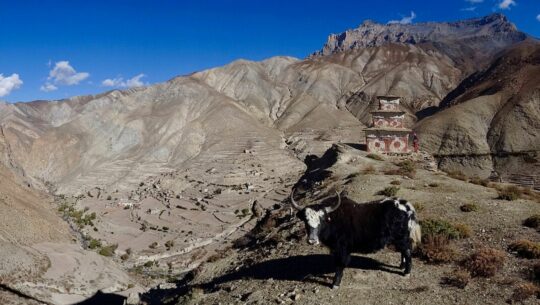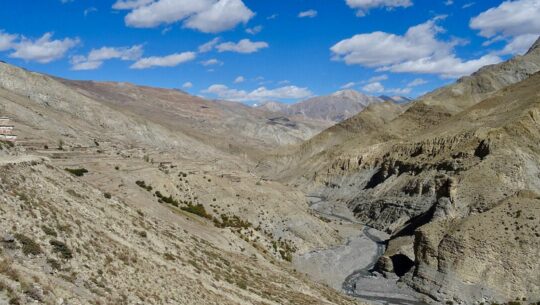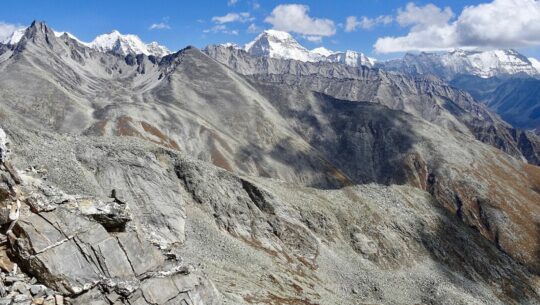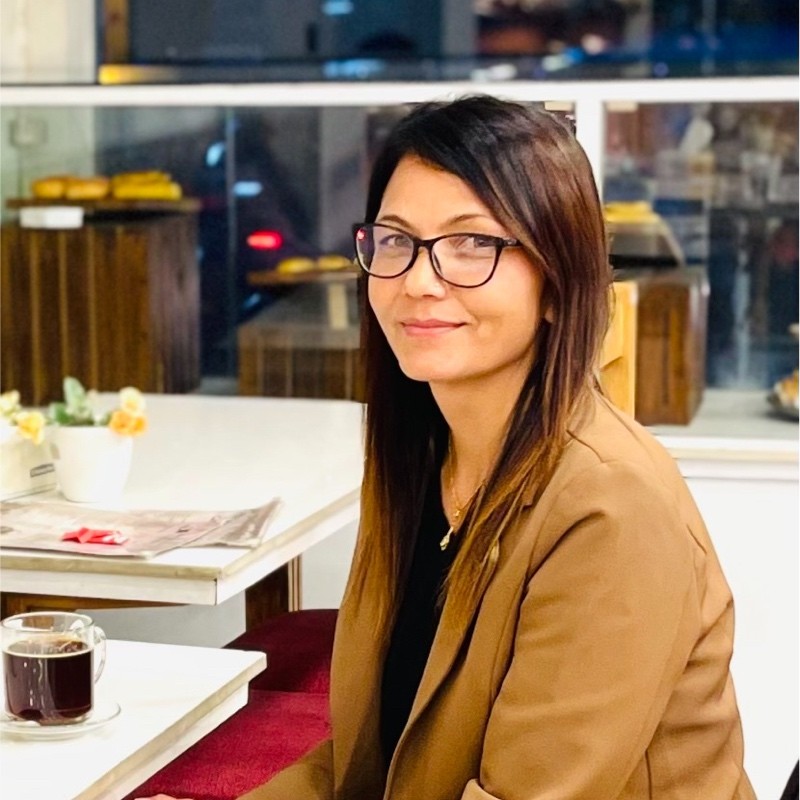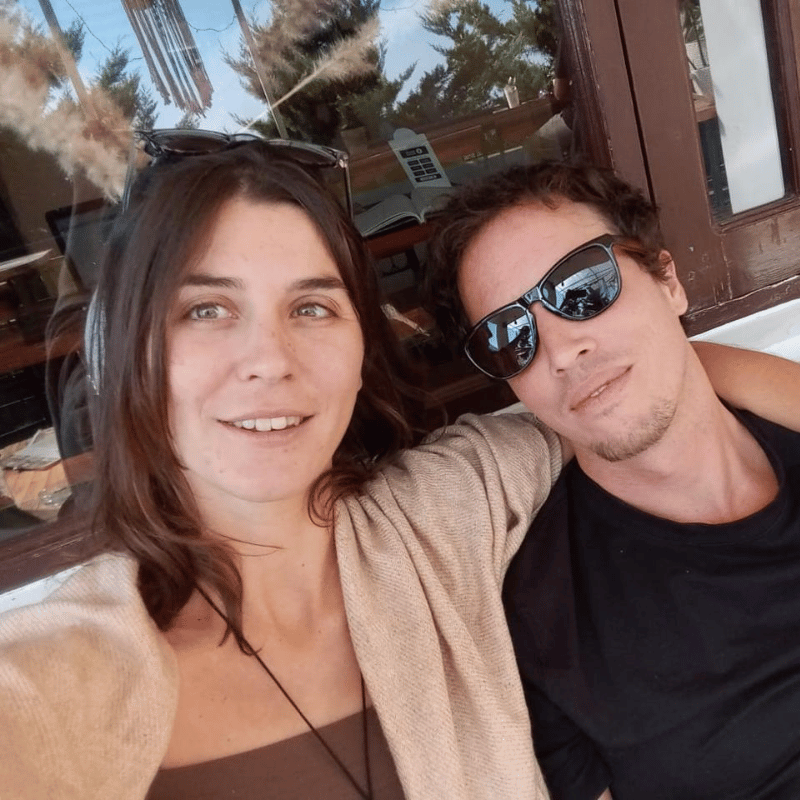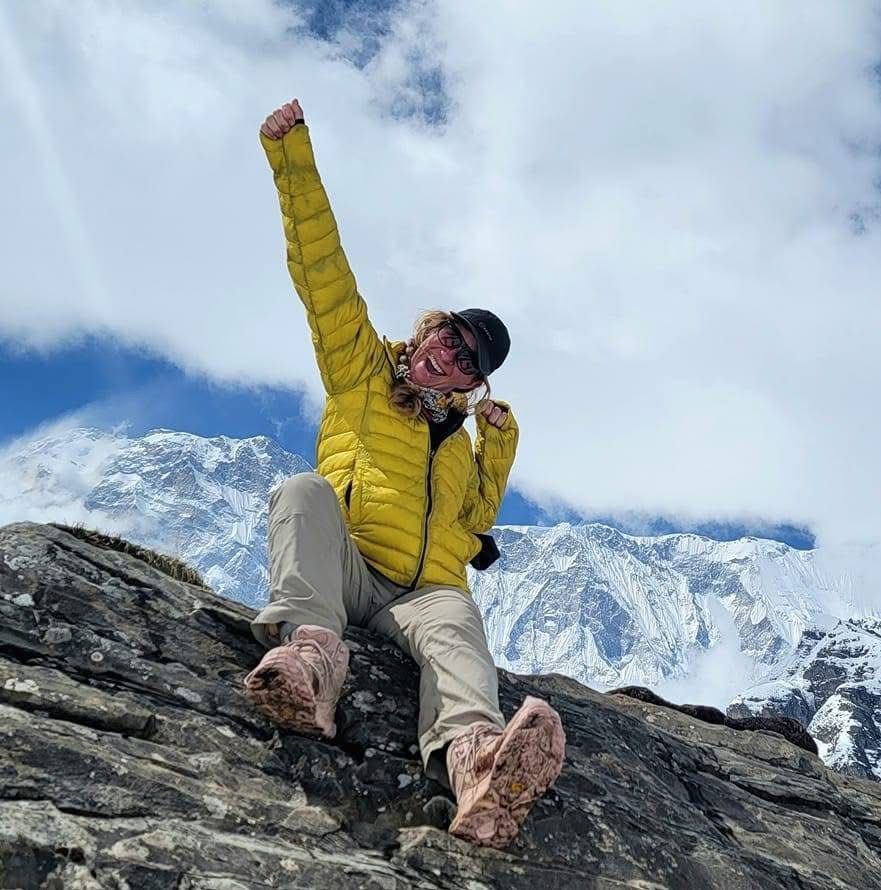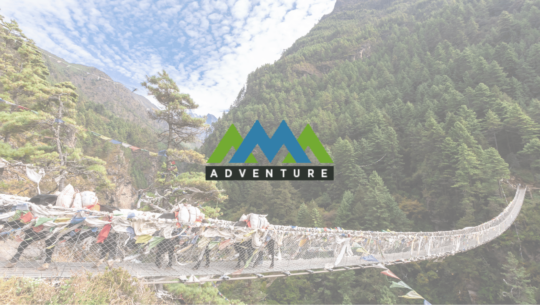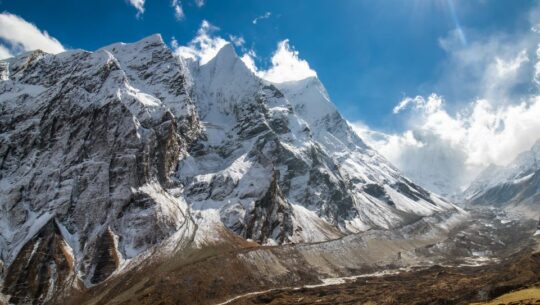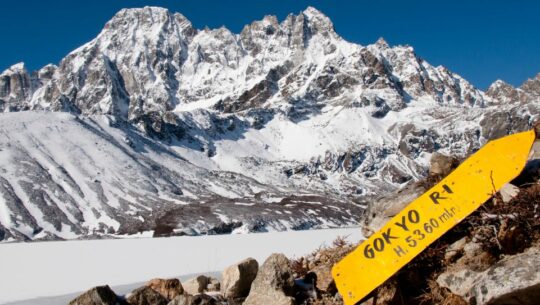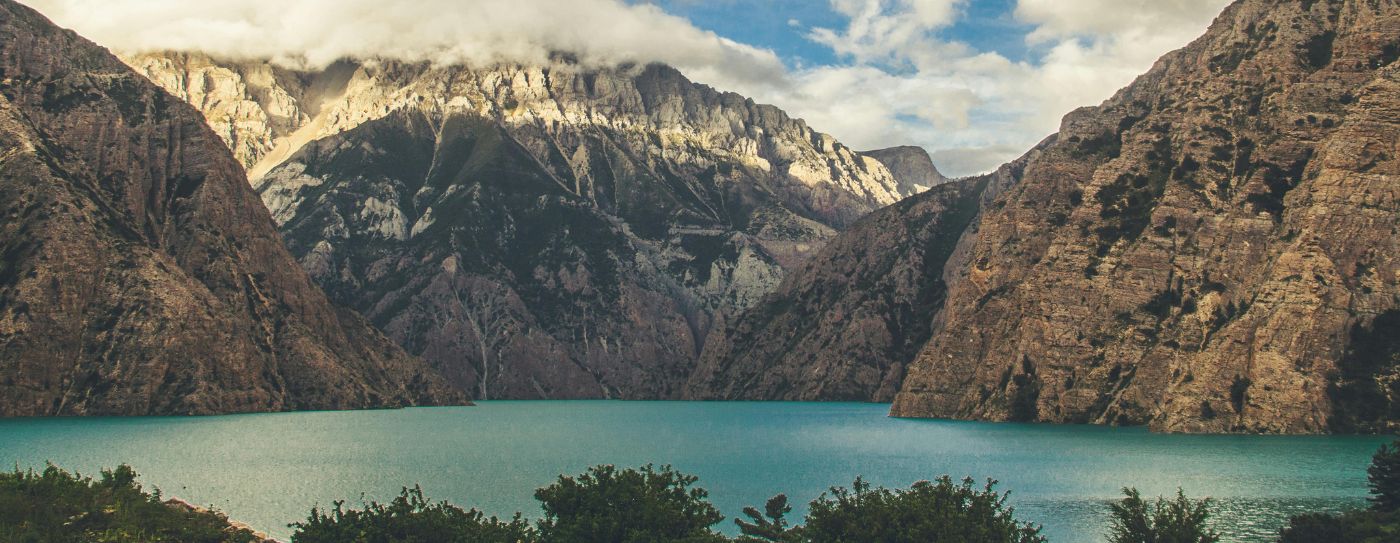
Upper Dolpo Valley Trek- 27 Days
The Upper Dolpo Trek takes you deep into one of Nepal’s most remote and untouched regions. Along the way, you’ll walk through wild landscapes, visit ancient monasteries, and experience the traditional mountain lifestyle that has remained unchanged for generations.
Nepal
25 Days
Challenging
5,306 m / 17,408 ft
Mar-May, Sep-Nov
Combination of hotels, teahouses, and tented camping
Included
Kathmandu
Trip Highlights
- Enjoy scenic mountain flights between Nepalgunj and Juphal
- Discover the beauty of Shey Phoksundo National Park, rich in nature and culture
- Cross dramatic high-altitude passes like Kang La, Saldang La, Jeng La, Numa La, and Baga La
- Visit centuries-old monasteries, including the sacred Shey Gompa
- Immerse yourself in the preserved Tibetan-influenced lifestyle of the locals
- Take in the breathtaking sight of the deep-blue Phoksundo Lake
- Walk through the remote and picturesque Nangkhong and Tarap Valleys
- Sleep under starlit skies at high camps, far from the noise of modern life
- Encounter unspoiled mountain landscapes, diverse plant and animal life, and timeless traditions
Trip Overview
The Upper Dolpo Trek takes you into one of Nepal’s most remote and less-traveled regions, often called the “land beyond the Himalayas.” It’s a special journey through wild landscapes, old monasteries, and traditional mountain villages. This place not only attracts the trekkers, it’s a living archive for many researchers and scholars for cultural and religious study. Dolpo is the rain shadow of the Himalayas traditionally locals used to rely on the trade with Tibetans for their livelihood.
The people themselves are the descendants of those who migrated from Tibet. The trek follows the isolated remote villages that bear evidence of the ancient trade route.This trekking is one of the most challenging and longer trekking in Nepal with various camps situated over 4500m along with many more high passes. Upper Dolpo region is completely far from its civilization; only listed travelers explore this remote area of Nepal.
The people in Dolpo Valley practice Tibetan Buddhism and some of them follow pre-Buddhist shamanistic and Bon religion. Tibetan culture is relatively more preserved in these areas making this region a more attractive travel destination.
The trek begins with a scenic flight to Juphal and then continues into Shey Phoksundo National Park, where the striking blue waters of Phoksundo Lake leave a lasting impression. The trail leads across high mountain passes like Kang La, Saldang La, and Jeng La, offering stunning views of the surrounding peaks and barren highlands.
This region holds strong ties to Tibetan Buddhist culture. You’ll visit monasteries such as Shey Gompa and meet people who still live by old traditions in villages above 4,300 meters.
Because of its isolation, Upper Dolpo has kept much of its original charm. You might see yak caravans on the trail and, with luck, spot wildlife like blue sheep or even a snow leopard.
The Upper Dolpo Trek is challenging but rewarding both physically and spiritually. It’s a real adventure through dramatic landscapes and into the heart of an ancient Himalayan culture.
Nepal’s first subtitled movie on Dolpo called “Snow Leopard” and “Caravan” was successful and nominated for the Oscar Award in the best foreign-language category.
Outline Itinerary
- Day 1: Arrival in Kathmandu (1300 m/4264 ft)
- Day 2: Swayambhunath tour and trip preparation
- Day 3: Fly to Nepalgunj
- Day 4: Fly to Jhupal (Dolpo) and trek to Dunai (2850 m/9,3448ft): 45m flight and 2-3 hrs trek
- Day 5: Trek to Ankhe (2,896 m/9,499 ft): 5-6 hrs
- Day 6: Ankhe to Sulighat: 5-6 hrs
- Day 7: Sulighat to Phoksundo Lake (3,611 m/11,849 ft): 4-5 hrs
- Day 8: Acclimatization, rest, and Phoksundo Lake
- Day 9: Trek to Phoksundo Khola: 4-5 hrs
- Day 10: Phoksundo Khola to Phoksundo Bhanjang: 6-7 hrs
- Day 11: Phokosundo Bhanjang to Shey Gompa (4500 m/14,760 ft) through Kangla passes (5,360 m/17,581 ft): 5–6 hrs
- Day 12: Acclimatization and Rest day at Shey Gompa
- Day 13: Shey Gompa to Namduna Gaun (4800 m/15,744 ft) via Saldang La (5,200 m/17,056 ft): 5-6 hrs
- Day 14: Namaduna Gaun to Saldang (3,620 m/11,874 ft) : 4-5 hrs
- Day 15: Saldang to Yangze Gompa (4,960 m/16,267 ft) : 4-5 hrs
- Day 16: Yangze Gompa to Sibu (4,560 m/14,957 ft) : 6-7 hrs
- Day 17: Sibu to Jeng via La Phedi (4,900 m/16,760 ft) : 6-7 hrs
- Day 18: Jeng la Phedi to Tokyo Gaun (4,200 m/13,809 ft) through Jeng la pass (5,090 m/16,695 ft): 5-6 hrs
- Day 19: Tokyo to Dho Tarap (4,040 m/13,251 ft): 4-5 hrs
- Day 20: Dho Tarap to Tarap Khola /Kamakharka (3,800 m/12,467 ft): 6-7 hrs
- Day 21: Tarap Khola /Kamakharka to Khanigaun (3,150 m/10,332 ft): 4-5 hrs
- Day 22: Khanigaun to Tarakot (2,537 m/8,321 ft): 4-5 hrs
- Day 23: Tarakot to Dunai (2,537 m/8,321 ft) 5-6 hrs
- Day 24: Dunai to Jhapal: 2-3 hrs
- Day 25: Fly Nepalgunj and Fly to Kathmandu
- Day 26: Rest Day in Kathmandu
- Day 27: Final Departure
Detailed Itinerary
Day 1: Arrival in Kathmandu (1300 m/4264 ft)
Upon arrival at the airport, we will be welcomed by a representative of Ama Adventure. Check into a hotel and then explore the surrounding area.
Max Altitude
: Kathmandu (1,300 m/4,264 ft)
Meals
: Breakfast
Overnight
: Kathmandu
Accomodation
: Hotel
Day 2: Swayambhunath tour and trip preparation
Max Altitude
: Kathmandu (1,300 m/4,264 ft)
Meals
: Breakfast
Overnight
: Kathmandu
Accomodation
: Hotel
Day 3: Fly to Nepalgunj
Trip Duration
: 1 hr
Meals
: Breakfast
Overnight
: Nepalgunj
Accomodation
: Hotel
Day 4: Fly to Jhupal (Dolpo) and trek to Dunai (2850 m/9,3448ft): 45m flight and 2-3 hrs trek
Max Altitude
: Dunai (2850 m/9,3448 ft)
Trip Duration
: 45 m flight and 2-3 hrs trek
Meals
: Breakfast, Lunch, Dinner
Overnight
: Dunai
Accomodation
: Hotel
Day 5: Trek to Ankhe (2,896 m/9,499 ft): 5-6 hrs
Max Altitude
: Ankhe (2,896 m/9,499 ft)
Trip Duration
: 5-6 hrs
Meals
: Breakfast, Lunch, Dinner
Overnight
: Ankhe
Accomodation
: Teahouse
Day 6: Ankhe to Sulighat: 5-6 hrs
Max Altitude
: Sulighat
Trip Duration
: 5-6 hrs
Meals
: Breakfast, Lunch, Dinner
Overnight
: Sulighat
Day 7: Sulighat to Phoksundo Lake (3,611 m/11,849 ft): 4-5 hrs
Max Altitude
: Phoksundo Lake (3,611 m/11,849 ft)
Trip Duration
: 4-5 hrs
Meals
: Breakfast, Lunch, Dinner
Overnight
: Phoksundo Lake
Accomodation
: Teahouse
Day 8: Acclimatization, rest, and Phoksundo Lake
Max Altitude
: Phoksundo Lake (3,611 m/11,849 ft)
Meals
: Breakfast, Lunch, Dinner
Overnight
: Phoksundo Lake
Accomodation
: Teahouse
Day 9: Trek to Phoksundo Khola: 4-5 hrs
Trip Duration
: 4-5 hrs
Meals
: Breakfast, Lunch, Dinner
Overnight
: Phoksundo Khola
Accomodation
: Teahouse
Day 10: Phoksundo Khola to Phoksundo Bhanjang: 6-7 hrs
Trip Duration
: 6-7 hrs
Meals
: Breakfast, Lunch, Dinner
Overnight
: Phoksundo Bhanjang
Accomodation
: Teahouse
Day 11: Phokosundo Bhanjang to Shey Gompa (4500 m/14,760 ft) through Kangla passes (5,360 m/17,581 ft): 5–6 hrs
Max Altitude
: Kangla Pass (5,360 m/17,581 ft)
Trip Duration
: 5-6 hrs
Meals
: Breakfast, Lunch, Dinner
Overnight
: Kangla Pass
Accomodation
: Teahouse
Day 12: Acclimatization and Rest day at Shey Gompa
Meals
: Breakfast, Lunch, Dinner
Overnight
: Shey Gompa
Accomodation
: Teahouse
Day 13: Shey Gompa to Namduna Gaun (4800 m/15,744 ft) via Saldang La (5,200 m/17,056 ft): 5-6 hrs
Max Altitude
: Saldang La (5,200 m/17,056 ft)
Trip Duration
: 5-6 hrs
Meals
: Breakfast, Lunch, Dinner
Overnight
: Namduna Gaun
Accomodation
: Teahouse
Day 14: Namaduna Gaun to Saldang (3,620 m/11,874 ft) : 4-5 hrs
Max Altitude
: Saldang (3,620 m/11,874 ft)
Trip Duration
: 4-5 hrs
Meals
: Breakfast, Lunch, Dinner
Overnight
: Saldang
Accomodation
: Teahouse
Day 15: Saldang to Yangze Gompa (4,960 m/16,267 ft) : 4-5 hrs
Max Altitude
: Yangze Gompa (4,960 m/16,267 ft)
Trip Duration
: 4-5 hrs
Meals
: Breakfast, Lunch, Dinner
Overnight
: Yangze Gompa
Accomodation
: Teahouse
Day 16: Yangze Gompa to Sibu (4,560 m/14,957 ft) : 6-7 hrs
Max Altitude
: Sibu (4,560 m/14,957 ft)
Trip Duration
: 6-7 hrs
Meals
: Breakfast, Lunch, Dinner
Overnight
: Sibu
Accomodation
: Teahouse
Day 17: Sibu to Jeng via La Phedi (4,900 m/16,760 ft) : 6-7 hrs
Max Altitude
: La Phedi (4,900 m/16,760 ft)
Trip Duration
: 6-7 hrs
Meals
: Breakfast, Lunch, Dinner
Overnight
: Jeng
Accomodation
: Teahouse
Day 18: Jeng la Phedi to Tokyo Gaun (4,200 m/13,809 ft) through Jeng la pass (5,090 m/16,695 ft): 5-6 hrs
Max Altitude
: Jeng la pass (5,090 m/16,695 ft)
Trip Duration
: 5-6 hrs
Meals
: Breakfast, Lunch, Dinner
Overnight
: Jeng la pass
Accomodation
: Teahouse
Day 19: Tokyo to Dho Tarap (4,040 m/13,251 ft): 4-5 hrs
Max Altitude
: Dho Tarap
Meals
: Breakfast, Lunch, Dinner
Overnight
: Dho Tarap
Accomodation
: Teahouse
Day 20: Dho Tarap to Tarap Khola /Kamakharka (3,800 m/12,467 ft): 6-7 hrs
Max Altitude
: Kamakharka (3,800 m/12,467 ft)
Trip Duration
: 6-7 hrs
Meals
: Breakfast, Lunch, Dinner
Overnight
: Kamakharka
Accomodation
: Teahouse
Day 21: Tarap Khola /Kamakharka to Khanigaun (3,150 m/10,332 ft): 4-5 hrs
Max Altitude
: Khanigaun (3,150 m/10,332 ft)
Trip Duration
: 4-5 hrs
Meals
: Breakfast, Lunch, Dinner
Overnight
: Khanigaun
Accomodation
: Teahouse
Day 22: Khanigaun to Tarakot (2,537 m/8,321 ft): 4-5 hrs
Max Altitude
: Tarakot (2,537 m/8,321 ft)
Trip Duration
: 4-5 hrs
Meals
: Breakfast, Lunch, Dinner
Overnight
: Tarakot
Accomodation
: Tea house
Day 23: Tarakot to Dunai (2,537 m/8,321 ft) 5-6 hrs
Max Altitude
: Dunai (2,537 m/8,321 ft
Trip Duration
: 5-6 hrs
Meals
: Breakfast, Lunch, Dinner
Overnight
: Dunai
Accomodation
: Teahouse
Day 24: Dunai to Jhapal: 2-3 hrs
Trip Duration
: 2-3 hrs
Meals
: Breakfast, Lunch, Dinner
Accomodation
: Hotel
Day 25: Fly Nepalgunj and Fly to Kathmandu
Max Altitude
: Kathmandu (1,300 m/4,264 ft)
Meals
: Breakfast
Overnight
: Kathmandu
Accomodation
: Hotel
Day 26: Rest Day in Kathmandu
Max Altitude
: Kathmandu (1,300 m/4,264 ft)
Meals
: Breakfast, Farewell Dinner
Overnight
: Kathmandu
Accomodation
: Hotel
Day 27: Final Departure
Gallery
What is included
Accommodation
- 4-star hotel in Kathmandu on a twin/double-sharing basis with breakfast
- 4-star hotel in Nepalgunj on a twin/double-sharing basis with breakfast
- Tented camp accommodation with full camping equipment for 17 nights during the trek. Provided equipment includes two-person tents, dining tents, kitchen equipment, dining table and chairs, toilet tents, and shower tents.
- Twin-sharing/double occupancy in teahouses(Meals will still be provided at the campsite. In case teahouses are fully booked, accommodation will be arranged in tented camps)
Meals & Drinking Water
- Breakfast, Lunch, and Dinner during the trek
- One hot drink per meal and seasonal fruits
- Welcome dinner in Kathmandu
- Farewell dinner on the final night in Nepal
- Purified drinking water throughout the trek (via water filter or purification tablets)
Transportation
- All airport transfers (international & domestic) by tourist vehicle
- Flight fare from Kathmandu – Nepalgunj – Juphal – Nepalgunj – Kathmandu including airport departure taxes
Guide & Support Staff
- Licensed, experienced, English-speaking trekking guide (2 guides for groups of 8 or more)
- Porter support (1 porter per 2 trekkers)
- All staff’s wages, accommodation, meals, insurance, gear, and medication
Permits & Entry Fees
- Special Trekking Permit US$ 70 per person per day and all local conservation fees
Health & Safety
- Comprehensive first aid kit
- Daily health checks with a pulse oximeter to monitor altitude-related symptoms
Extras & Souvenirs
- Duffle/kit bag, and a trip completion certificate
Administrative
- All government taxes and administrative fees
What is Excluded
- Meals in Kathmandu – Lunch and dinner while in Kathmandu
- International airfare and airport departure tax
- Travel insurance – Must include high-altitude emergency evacuation coverage
- Alcoholic beverages, cold drinks, and bottled juices
- Tips – For trekking staff and drivers (at your discretion)
- Personal trekking gear and equipment
- Single room supplement – Available on request at an extra cost
- Any expenses not mentioned in the Price Includes section
- Nepal Entry Visa – Payable on arrival at Tribhuvan International Airport:
• USD 30 for 15 days
• USD 50 for 30 days
• USD 125 for 90 days
Trip Departure
We offer both solo and group bookings to make your holiday a lifetime memory with people from all over the world. Once your trip is confirmed, we guarantee all group departure dates, even if only one person has signed up for the trek. Please note that before departure, we always confirm the current number of members in your group before final registration.
Difficulty Level
This trek is 5-6 hours a day. Some days we may have to walk for 9- 10 hours. Walking at a higher altitude is physically more demanding than walking at a lower altitude; However, if you are in good shape and of
average physical shape, with a positive attitude towards life and firm determination, you can complete the trek successfully.
Regular exercise and jogging is a good way to increase strength and stability. For the trek, you need to pack essential personal items, which can vary based on your preferences. Preparing for the cold weather in the Himalayas is crucial, so bring sufficient warm clothing.
During a supported trek, porters will carry heavy items, while you are responsible for carrying daily necessities like water bottles, rain gear, a camera, sun cream, and toilet paper.
Dates & Prices
All our published departure dates are guaranteed. If none of the available dates suit you, we can customize the trek to match your timing. Just let us know your travel window and group details, and we’ll help you organize a private or custom Upper Dolpo Trek that fits your needs.
Meals
Throughout our trek, you’ll savor authentic Nepalese dishes alongside international cuisines such as Tibetan, Continental, Italian, and Indian. Breakfast and dinner will be served at the tea houses or lodge menus where we stay overnight, while lunches will be provided en-route to our next destination. During the trek, all meals are included. In Kathmandu, breakfast is provided, and special welcome and farewell dinners will be arranged for our guests.
Accomodation
We’ll be accommodated at Standard Hotel in Kathmandu, and the best available teahouses during our trek. Accommodations are based on twin sharing. For those requesting a single room, there will be an additional cost of USD 150. While we aim for rooms with attached washrooms, please note that some tea houses may only have shared washing and toilet facilities. Single rooms are readily available in Kathmandu, Pokhara, and lower-elevation trekking areas, but availability might be limited at higher elevations.
Weather Information
The best seasons to trek in Upper Dolpo are from March to May and September to November. These months typically offer clear skies, stable weather, and excellent mountain views. During the trek, daytime temperatures at lower altitudes usually range between 10°C to 20°C, making it comfortable for walking. However, as you ascend to higher elevations and cross high passes like Numa La and Baga La, nighttime temperatures can drop to -6°C or even lower. Snowfall is possible at higher altitudes, particularly in late autumn and early spring. Since the Dolpo region is remote and weather patterns can change unexpectedly, it’s important to come well-prepared with appropriate clothing and gear.
Packing List
Here’s a suggested packing list to help you get ready for the Upper Dolpo Valley Trek- 27 Days. Please take this as a starting point. You’ll need layers of warmer clothing during the winter.
We provide a 75-liter duffel bag for you to use for the trek. It will be given to you during your pre-trip meeting in Kathmandu. The duffle bag is yours to keep.
General
- Four-season sleeping bag (rated to 0°C or lower) (Rental available: USD 35)
- Sleeping bag liner
- Insulated down jacket (Rental available: USD 35)
- Daypack (35-45 liters recommended) with rain cover
Upper Body
- Sun hat or cap (Complimentary Ama Adventure cap included)
- Warm knitted hat or beanie
- Scarf or neck gaiter (Buff recommended)
- Headlamp with extra batteries
- UV-protection sunglasses
Torso
- Moisture-wicking base layers – lightweight for warmer seasons, thermal for colder months
- Two short-sleeve and two long-sleeve trekking shirts made of quick-dry technical fabric
- Windproof and waterproof outer shell or jacket
- Warm fleece jacket or pullover for added insulation
Lower Body
- Thermal base layers – lightweight for warm months, heavier for cold conditions
- Two pairs of durable hiking pants
- Comfortable pants for relaxing inside teahouses
- Waterproof and windproof shell pants for protection against rain and wind
- One pair of hiking shorts (ideal for lower altitudes and warm days)
Hands
- Liner gloves made of wool or technical fabric for warmth and flexibility
- Insulated outer gloves with a hard shell – ideal for wind and cold at higher altitudes
Feet
- Warm socks made of wool or technical fabric
- Hiking socks (several pairs recommended)
- Optional liner socks (e.g., silk) for added comfort and blister prevention
- Waterproof trekking/hiking boots – well broken-in before the trek
- Ice Cleats or Micro Spikes (recommended from November to March for icy trails)
- Comfortable casual shoes or sandals for teahouse use
- Gaiters – lightweight for dust or heavier ones for snow in cold months
Undergarments
Note: Laundry opportunities are limited, so pack accordingly.
- Quick-drying, moisture-wicking underwear (technical fabric recommended) – adjust quantity based on personal preference
- Sports bras (for women) – supportive and breathable
- Pajamas or comfortable sleepwear for chilly nights in the mountains
First Aid Kits and Medications
- Sunscreen (high SPF)
- Lip balm with SPF
- Antiseptic or soothing ointment
- Personal medications (for altitude, allergies, pain relief, etc.)
(Note: Our guides carry a basic first aid kit, but personal supplies are strongly recommended)
Other Essential Items
- Power bank or spare batteries
- Wet Wipes
- Reusable water bottle or hydration bladder
- Water purification tablets or UV water purifier
- Headlamp
- Lightweight towel
- Basic Medicine (Pepto, Bismol, Advil, Imodium)
- Bandana for dust and wind
- Toiletry kit (toothbrush, toothpaste, wipes, etc.)
- Toilet paper (2 rolls minimum)
- Personal Medicine and Toiletries
- High-protein snacks (nuts, energy/protein bars)
- Waterproof/dry bags to protect documents and valuables
- Ziplock Bag for Toilet papers and other necessary items
Optional
(These can enhance your comfort during the trek and are widely available in Thamel, Kathmandu)
- Power bank or spare batteries
- Camera and mobile phone (for capturing memories)
- Cards, books, or lightweight entertainment
- Pee bottle or pee funnel (especially useful for women at high altitudes)
- Trekking poles (highly recommended for stability)
- Whistle (for safety/emergency use)
- Thermos (to carry hot water/tea during cold days)
Tip: Thamel is full of gear shops where you can purchase or rent trekking essentials at a reasonable price once you’re in Kathmandu.
Documents and Logistics
- Flight Information
- Photocopy of Passport
- Passport size photo for Tims and permit(4)
- Medical Insurance Card
- Airline tickets (leave a copy with our office in Kathmandu)
Dates & Prices
We ensure departures on all published dates. If these dates don’t align with your plans, we’re happy to assist in setting a customized date. Whether you’re a solo traveler, a couple, a family, or a group seeking private trips, you can tailor-make your adventure. Reach out to us for pricing details or any other queries.
Group Discount Prices
Frequently Asked Questions
Traveler Reviews


